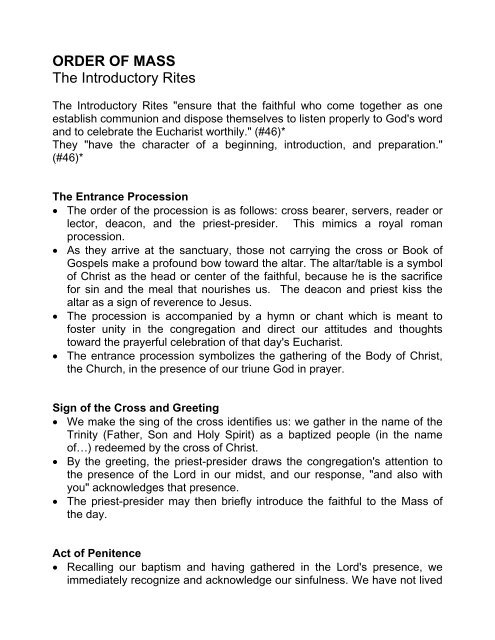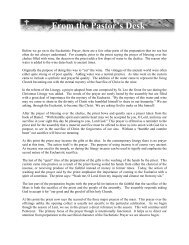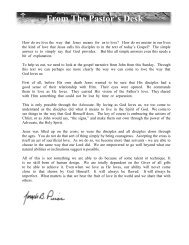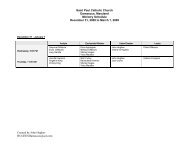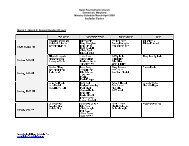ORDER OF MASS: - St. Paul's Catholic Church
ORDER OF MASS: - St. Paul's Catholic Church
ORDER OF MASS: - St. Paul's Catholic Church
Create successful ePaper yourself
Turn your PDF publications into a flip-book with our unique Google optimized e-Paper software.
<strong>ORDER</strong> <strong>OF</strong> <strong>MASS</strong><br />
The Introductory Rites<br />
The Introductory Rites "ensure that the faithful who come together as one<br />
establish communion and dispose themselves to listen properly to God's word<br />
and to celebrate the Eucharist worthily." (#46)*<br />
They "have the character of a beginning, introduction, and preparation."<br />
(#46)*<br />
The Entrance Procession<br />
• The order of the procession is as follows: cross bearer, servers, reader or<br />
lector, deacon, and the priest-presider. This mimics a royal roman<br />
procession.<br />
• As they arrive at the sanctuary, those not carrying the cross or Book of<br />
Gospels make a profound bow toward the altar. The altar/table is a symbol<br />
of Christ as the head or center of the faithful, because he is the sacrifice<br />
for sin and the meal that nourishes us. The deacon and priest kiss the<br />
altar as a sign of reverence to Jesus.<br />
• The procession is accompanied by a hymn or chant which is meant to<br />
foster unity in the congregation and direct our attitudes and thoughts<br />
toward the prayerful celebration of that day's Eucharist.<br />
• The entrance procession symbolizes the gathering of the Body of Christ,<br />
the <strong>Church</strong>, in the presence of our triune God in prayer.<br />
Sign of the Cross and Greeting<br />
• We make the sing of the cross identifies us: we gather in the name of the<br />
Trinity (Father, Son and Holy Spirit) as a baptized people (in the name<br />
of…) redeemed by the cross of Christ.<br />
• By the greeting, the priest-presider draws the congregation's attention to<br />
the presence of the Lord in our midst, and our response, "and also with<br />
you" acknowledges that presence.<br />
• The priest-presider may then briefly introduce the faithful to the Mass of<br />
the day.<br />
Act of Penitence<br />
• Recalling our baptism and having gathered in the Lord's presence, we<br />
immediately recognize and acknowledge our sinfulness. We have not lived
fully and faithfully the life of Christ. So by an act of penitence we call to<br />
mind our sins and recommit ourselves to live in Christ.<br />
• There are ten different formulas that can be used here. In one way or<br />
another, the petition Kyrie eleison (Greek for "Lord, have mercy") is used.<br />
This is really the only prayer we can ever say when we recognize our sin<br />
and unworthiness before God.<br />
• During Lent and at other appropriate times, the act of penitence and Kyrie<br />
are sung and the attitude of repentance enhanced by kneeling during it.<br />
• On some Sundays, especially during the Easter season, the blessing and<br />
sprinkling of water may replace the act of penitence. This rite emphasizes<br />
the cleansing waters of baptism and recommits us to live our baptismal<br />
promises.<br />
The Gloria<br />
• The Gloria, or "Glory to God," is a very ancient hymn of praise introduced<br />
into the liturgy in the 6 th century. Originally only a bishop intoned the<br />
Gloria.<br />
• The first lines of which echo the song of the angels who announced the<br />
birth of Jesus to the shepherds. It is a series of acclamations, naming God<br />
with wonder and awe.<br />
• Ordinarily, the Gloria is sung by all either in unison or alternately with<br />
choir/cantor and congregation.<br />
• The Gloria is omitted during the season of Advent so that we may sing the<br />
song of the angels with renewed joy at Christmas. It is also omitted during<br />
the season of Lent because there is no room for such exuberant joy when<br />
we are reckoning with our sin.<br />
The Collect<br />
• The priest-presider then invites the congregation to pray. A brief moment<br />
of silence allows a prayerfulness to settle over the community as we<br />
continue to remember the presence of the Lord and to join our individual<br />
prayers with the prayer of all.<br />
• The Collect (Opening Prayer) is prayed aloud by the presider. It gathers or<br />
collects together all the prayers we come with in the spirit of the<br />
Eucharistic celebration that has now begun.<br />
• The people's response, "Amen" makes the prayer their own.<br />
• The Collect changes each week for the particular Sunday or special<br />
occasion.
*General Instruction of the Roman Missal
<strong>ORDER</strong> <strong>OF</strong> <strong>MASS</strong><br />
The Liturgy of the Word<br />
"When the Sacred Scriptures are read in the <strong>Church</strong>, God himself speaks to<br />
his people, and Christ, present in his own word, proclaims the Gospel." (#29)*<br />
"For in the readings, as explained by the homily, God speaks to his people,<br />
opening up to them the mystery of redemption and salvation, and offering<br />
them spiritual nourishment; and Christ himself is present in the midst of the<br />
faithful through his word. By their silence and singing the people make God's<br />
word their own, and they also affirm their adherence to it by means of the<br />
Profession of Faith. Finally, having been nourished by it, they pour out their<br />
petitions in the Prayer of the Faithful for the needs of the entire <strong>Church</strong> and<br />
for the salvation of the whole world." (#55)*<br />
We fast for at least one hour before Mass so that we bodily experience the<br />
hunger we have for God’s Word and Sacrament.<br />
The Lectionary<br />
The lectionary is the collection of readings used for daily and Sunday Masses<br />
and for Masses on special occasions.<br />
Sunday Mass Three Year Cycle<br />
Matthew - Year A, Mark - Year B, Luke - Year C,<br />
John - every year during Lent and Easter<br />
Daily Mass Two Year Cycle<br />
Each <strong>Church</strong> Yea year begins on the first Sunday of Advent.<br />
The first two readings and the Psalm are chosen in light of the Gospel.<br />
The First Reading and the Psalm foreshadow the life of Jesus and the<br />
Second is a discussion of the life of Christ lived out in the early Christian<br />
community.<br />
The Lectionary uses the New American Bible translation.<br />
First Reading<br />
Taken from the Hebrew Scriptures (Genesis, Exodus, Deuteronomy, Kings,<br />
Wisdom, Isaiah, Jeremiah and others) or from the Acts of the Apostles<br />
(Easter Season). The lector ends by saying “The Word of the Lord” and the<br />
assembly responds “Thanks be to God.” We often say those words too<br />
habitually.
Responsorial Psalm<br />
Taken from the body of 150 Hebrew songs of blessing, cursing, ballads and<br />
lamentations. They would have been sung in Jewish worship services at the<br />
time of Jesus. They were/are a communal way of expressing emotions.<br />
Second Reading<br />
Taken from the letters (epistles) of early Christian writers such as Paul, John<br />
Peter and unknown authors. Most of the letters were written before the<br />
Gospels.<br />
Gospel Acclamation<br />
We stand and sing for joy in thanksgiving for the Word of God given to us.<br />
Gospel Reading<br />
Jesus the Christ continues to reveal himself to us in the stories and teachings<br />
of the gospel narratives. We stand in joyful attention to hear his words, as the<br />
eager crowds of his own time did.<br />
Having heard the Word so central to our faith, our acclamation is more<br />
elaborate: "Praise to you, Lord Jesus Christ." The priest or deacon kisses the<br />
Book of Gospels as a sign of reverence and affection for Jesus.<br />
Homily<br />
An extension of the Scripture readings as it applies to the current experience<br />
of Christians. We again are silent for a moment to let the words of the gospel<br />
sink in. Two things the homilist must take into consideration - God’s saving<br />
work (the paschal mystery) and the needs of the community. (#41)<br />
The Profession of Faith<br />
We respond to God's Word for us by recommitting ourselves to living God's<br />
Word by renewing our Profession of Faith (or Creed). As a family of faith we<br />
reaffirm the tenets of our faith. We stand together as a sign that we stand<br />
together in the faith. We bow at the words, "by the power of the Holy Spirit,<br />
he was born of the Virgin Mary, and became man."<br />
The Prayers of the Faithful<br />
Having heard with hope the saving promise of God through the readings, we<br />
pray for the salvation of all. This Prayer of the Faithful intercedes in one way<br />
or another for the needs of the <strong>Church</strong>, for public authorities and the salvation<br />
of the world, for those burdened by any kind of difficulty, for the local
community, and for those who have died. We pray so that we are reminded<br />
to respond to the needs of others.<br />
*General Instruction of the Roman Missal
<strong>ORDER</strong> <strong>OF</strong> <strong>MASS</strong><br />
The Liturgy of the Eucharist<br />
Presentation of the Gifts<br />
Basic elements of bread and wine are and brought forward with the offering of<br />
the community as a symbol of our lives being brought to the altar. They<br />
represent not just basic food and drink; but more they represent our whole<br />
lives. All that our lives are about - our work, our struggles, our hopes, our<br />
joys, our hungers, our satisfactions - are symbolized in these gifts. We are<br />
united in our offering, just as many grains make one loaf and many grapes<br />
make one cup. The donations of money and gifts for the poor also symbolize<br />
the gift of our lives to God. These gifts are given in response to the Word of<br />
God to support the mission of Christ through the parish community. A Prayer<br />
over the Offerings is then prayed as a way to express our intention and hopes<br />
for these gifts.<br />
Offertory Prayer<br />
This was one of the most radical of reforms in the Mass of Paul VI is the use<br />
of the words and gestures of an ancient Jewish blessing (berakah) over the<br />
gifts.<br />
Baruch Atah Adonai Eloheinu Melech ha'olam Borei peri ha-gafen.<br />
Blessed are you Lord, Eternal God, Sovereign of the universe, Creator of the fruit of the<br />
vine.<br />
Jesus may have followed a Passover format (I.e. celebrating the Exodus) for<br />
the Last Supper but the fact is for religious Jews, all significant meals were<br />
ritualized.<br />
The Jewish blessing celebrates the promise of the Kingdom of God whereas<br />
Christians use the same blessing to celebrate the fulfillment of the promise.<br />
The priest symbolically washes his hands as a sign of purification. This ritual<br />
originated when the offertory included farm products and the priest needed to<br />
wash his hands.<br />
The Eucharistic Prayer<br />
The Eucharistic Prayer is addressed to God the Father who sends the Holy<br />
Spirit to consecrate the offerings through the power of the Holy Spirit, so that<br />
our gifts of bread and wine (our lives) become the Body and Blood of Christ.<br />
This is a prayer of sacrifice and thanksgiving. Thankfulness is given to God<br />
for the whole work of salvation and the Holy Spirit is called to make our<br />
offerings holy as they become the Body and Blood of Christ.
The priest invites the congregation to lift up their hearts to the Lord as "he<br />
unites the congregation with himself in the prayer that he addresses in the<br />
name of the entire community to God the Father through Jesus Christ in the<br />
Holy Spirit." The entire congregation, with one voice (literally - the voice of the<br />
priest), joins itself with Christ in confessing the great deeds of God and in<br />
offering the sacrifice.<br />
We stand for The Preface which is a highly variable, changing with the<br />
particular day, feast, occasion or liturgical season. It states our motives for<br />
praising and glorifying God and leads to The Sanctus (Holy, Holy, Holy).<br />
After the Sanctus we kneel for the main body of the Eucharistic Prayer.<br />
There are ten (10) Eucharistic Prayers currently approved for use in the<br />
dioceses of the United <strong>St</strong>ates: Eucharistic Prayer I or The Roman Canon (4 th<br />
Century), Eucharistic Prayer II (3 rd Century), Eucharistic Prayer III (20 th<br />
Century composition based on the Roman Canon), Eucharistic Prayer IV (4 th<br />
Century), two Eucharistic Prayer of Reconciliation (used in Lent and other<br />
appropriate occasions), three Eucharistic Prayers for Masses with Children,<br />
and a Eucharistic Prayer for Masses for Various Needs and Occasions (also<br />
used for appropriate occasions).<br />
The Epiclesis is when we ask God to send the Holy Spirit on our gifts of bread<br />
and wine (let your Spirit come upon these gifts…). Later there is a second<br />
epiclesis for the <strong>Church</strong>, and all the living and dead. We end the Prayer with<br />
a Doxology which praises all three persons in the Blessed Trinity.<br />
The centerpiece of this prayerful remembrance is the Institution Narrative. We<br />
remember how "on the night he was betrayed," Jesus took the bread and cup<br />
and said "This is my Body, this is my Blood." This is followed by the Memorial<br />
Acclamation which speaks of the paschal mystery (death & resurrection of<br />
Jesus). There are Intercessions in the Eucharistic Prayer as well (for the<br />
pope, bishop, deceased, etc…). Through them we pray in communion with<br />
those in heaven for the needs of the living and the dead. The Great Amen,<br />
sung by the congregation, gives consent to all that has been voiced by the<br />
priest.<br />
The Altar<br />
The Eucharist is both a sacrifice and a meal. We are united with Jesus’<br />
sacrifice on the cross as we offer our lives in sacrifice (symbolized by the<br />
bread and wine). Like the disciples attending the Last Super, the Eucharist is<br />
also a meal at which we receive spiritual nourishment. Altars that are large<br />
slabs of stone emphasize the sacrificial aspect of Eucharist. Altars that look
like tables emphasize the meal aspect. The altar at <strong>St</strong>. Paul incorporates<br />
both aspects.<br />
Gestures<br />
The ritual of the Eucharistic Prayer is a series of gestures married in a logical<br />
coherence. For example the priest extends his arms in a gesture of collecting<br />
the prayers of the community and lifting them to God. Unlike a staged<br />
performance, the words and actions are not a reenactment of the past. The<br />
words and gestures bring about the change from bread and wine to the body<br />
and blood of Jesus.
<strong>ORDER</strong> <strong>OF</strong> <strong>MASS</strong><br />
The Communion & Closing Rites<br />
The Lord's Prayer<br />
In The Lord's Prayer we continue our praise of God ("hallowed be Thy name")<br />
and make two petitions. We ask for "daily bread," an early description of the<br />
Eucharistic food, that we might be nourished in spirit. We ask for forgiveness<br />
of our trespasses, so that what is holy may be given to people who are holy.<br />
The Rite of Peace<br />
In the sign of peace we ask for peace and unity for the <strong>Church</strong> and for the<br />
whole human family. And we demonstrate our own commitment to be<br />
instruments of peace, unity and mutual love through our sharing a greeting of<br />
peace with those immediately around us. This act anticipates the unity and<br />
reconciliation that are ours in our communion with Christ.<br />
The Fraction Rite with the Lamb of God<br />
The Fraction, or the breaking of bread, is a simple but powerful action. The<br />
one loaf is broken into many pieces just as Christ was broken and his blood<br />
poured out for the many. We, though many, become one with Christ by our<br />
sharing this one bread and one cup in the same way the apostles received<br />
them from Christ's own hands. Having all hosts come from one bread and<br />
everyone drinking from one cup is an ideal but not practical in a large<br />
congregation.<br />
During this action of breaking bread we sing the litany "Lamb of God," humbly<br />
expressing our awe and unworthiness for so great a gift as Christ, the Lamb<br />
who was slain for our sake. Lambs were sacrificial animals. Through this<br />
prayer we recognize that Jesus is the one sacrifice for all time eliminating the<br />
need for animal sacrifices.<br />
Taking a small piece of a host the priest drops it in the Precious Blood while<br />
saying: “May this mingling of the body and blood of our Lord Jesus Christ<br />
bring eternal life to us who receive it.” The action signifies that Jesus is one<br />
body and blood even though they are separated in various vessels.<br />
Communion Procession
In the Communion Rite of Mass, we fulfill the command of the Lord Jesus at<br />
the Last Supper: "Take and eat, take and drink." We are fed by "the bread of<br />
life and the cup of eternal blessing." This simple meal is the gift of Christ's<br />
very self: "This is my Body, which is given up for you, the cup of my Blood,<br />
shed for you and for all."<br />
Our procession to the Eucharistic table is accompanied by our singing,<br />
another way of uniting ourselves with our brothers and sisters in Christ. For<br />
such a gift as we are receiving in this Act of Communion, how can we keep<br />
from singing our praise and gratitude<br />
The General Instruction invites us to bow our heads before receiving the<br />
sacrament as an act of reverence. Genuflecting in the communion line or<br />
kneeling for communion is not proper because it becomes a private act of<br />
worship and breaks communion. Each communicant decides for him/herself<br />
whether to receive the consecrated host in the hand or on the tongue.<br />
Prayer After Communion<br />
When the Act of Communion is over, we pray silently for a moment or two,<br />
then stand and collect our prayers together in The Prayer after Communion.<br />
This is a petition whereby we ask that the grace we have received through<br />
participation in the Eucharist bear fruit in our daily lives and leads us to<br />
everlasting life.<br />
The Final Blessing<br />
The final blessing is a seal upon the graces received in the celebration of the<br />
Eucharist. Then we are then ready to take what we have received in this<br />
celebration of Mass out into our daily lives and the world in which we live.<br />
The blessing reminds us that we are on a mission to build up the kingdom of<br />
God. We need to be sent out to the world with the blessing of the <strong>Church</strong>.<br />
The Dismissal<br />
This is a charge to go and serve the world in whatever capacity (vocation)<br />
God has called us.<br />
Sundry Items<br />
Reverence and Fellowship<br />
Holy Water Fonts
Bells<br />
Cultic Action and Social Action


